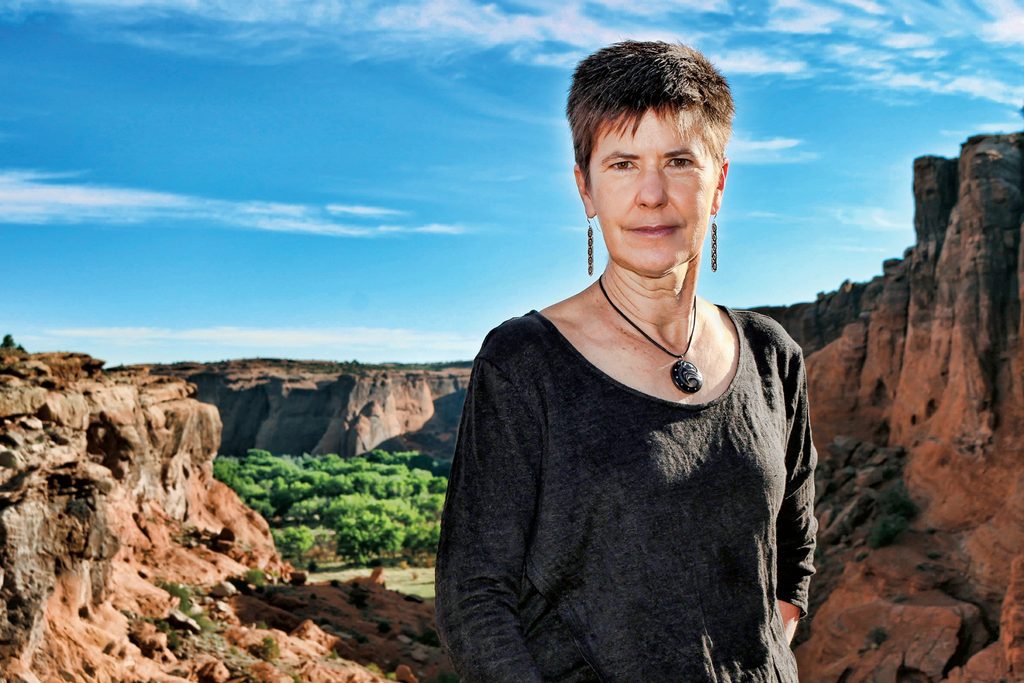In May the Navajo Nation had one of the highest infection rates in the country. By July, thanks to the collaborative efforts of health care workers and doctors like Jill Moses ’86, the numbers had improved drastically.

From its low, arid deserts and lush alpine forests to its high plateaus, mesas, and mountains, the Navajo Nation spans more than 27,000 square miles in northeastern Arizona, New Mexico, and Utah. It’s the largest reservation in the United States, home to roughly 170,000 people.
There’s both strength and struggle here. The Navajo, or Diné, depend equally on self-su ciency and community, valuing cultural traditions as part of contemporary life. They also have endured historical trauma and face high rates of poverty, diabetes, injuries, and suicide. Many people live in crowded, multigenerational homes. More than 30 percent lack running water, 10 percent have no electricity, and internet and cell phone coverage is sparse and unpredictable. So when the coronavirus hit in mid-March, infections soon soared on the reservation.
Chinle, Arizona, is a short distance from the stunning Canyon de Chelly National Monument and home to the Chinle Comprehensive Health Care Facility (CCHCF), where Jill Moses ’86 and her team have worked tirelessly to curb the coronavirus. A pediatrician, Moses is director of the Chinle Service Unit (CSU) Division of Public Health. CSU is part of the Navajo Area Indian Health Service, an agency within the U.S. Department of Health and Human Services that works with 11 other Indian Health Service (IHS) units in 36 states.
As soon as the coronavirus was on their radar, Moses and her colleagues went to work to contain its spread, scaling up their workforce and their disease-control systems. “Once people jumped in, the pace and intensity of response was impressive,” she says.
From the beginning, Moses and CSU—working closely with the Navajo Nation’s own public health program, as well as IHS, nonprofits, and other federal, state, and county partners emphasized community information: radios, billboards, newspapers, and social media all spread the message about the importance of wearing masks. CSU did extensive coronavirus testing across the Navajo reservation.
Contact tracing, case investigations, and follow-up have exceeded efforts elsewhere in the region. “We know what’s happening in our communities regarding who gets COVID-19 and from whom,” says Moses. Many of the area’s hotels have turned empty rooms into isolation sites and, as of July, there were enough beds at the CCHCF, and its intensive care unit was able to meet demand.
“It’s been a massive undertaking,” says Moses. “We’ve done an incredible job here, given how remote we are. We got through the first surge, plateaued, and have come down the other side. We have seen COVID-19 decrease on the Navajo reservation for weeks.
“But the rest of Arizona has skyrocketed in number of cases and that makes us uncomfortable. People on the reservation rely on Phoenix and other towns for supplies, so there’s a lot of going back and forth. We’re concerned about the impact of that. We’re in it for the long haul. We place a high priority on public health.”
Growing up in Byron, Minnesota, Moses often spent weekends with her father—renowned cancer researcher Hal Moses—in his Mayo Clinic lab. Those visits made a deep impression on her, and in her senior year as a Carleton biology major, she decided to pursue an MD at Vanderbilt.
In medical school, Moses was introduced to public health, and to the IHS during a rotation at its hospital in Shiprock, New Mexico, also in the Navajo Nation. She carried her interest in public health into her residency in pediatrics and preventive medicine at Johns Hopkins, where she earned a master’s degree in public health in 1995. Moses wanted to practice clinical medicine as well as pursue public health, and she found the opportunity in Chinle in 1996.
She has since increased CSU’s public health office staff from 14 to more than 80 and set up programs in population health, injury prevention, school health, diabetes, and community nutrition. In 2001 she created the facility’s Division of Public Health and, with the participation of traditional Navajo healers, expanded the Office of Native Medicine. Moses received a Distinguished Achievement Award from the Carleton Alumni Association in 2011.
“I feel like everything I’d been working toward in my life has led me to this point,” Moses says. “The clinical and public health infrastructure we’ve built over the years at CSU has helped us be as prepared as we possibly can be to deal with the coronavirus. It’s been a long, hard road. I do have my moments of despair and exhaustion. But it’s reassuring to know that whatever lies ahead, we’re capable of meeting the challenge, that whatever happens, we know we can get through it.”
Read more about Carls making a difference on the frontlines of COVID-19.
